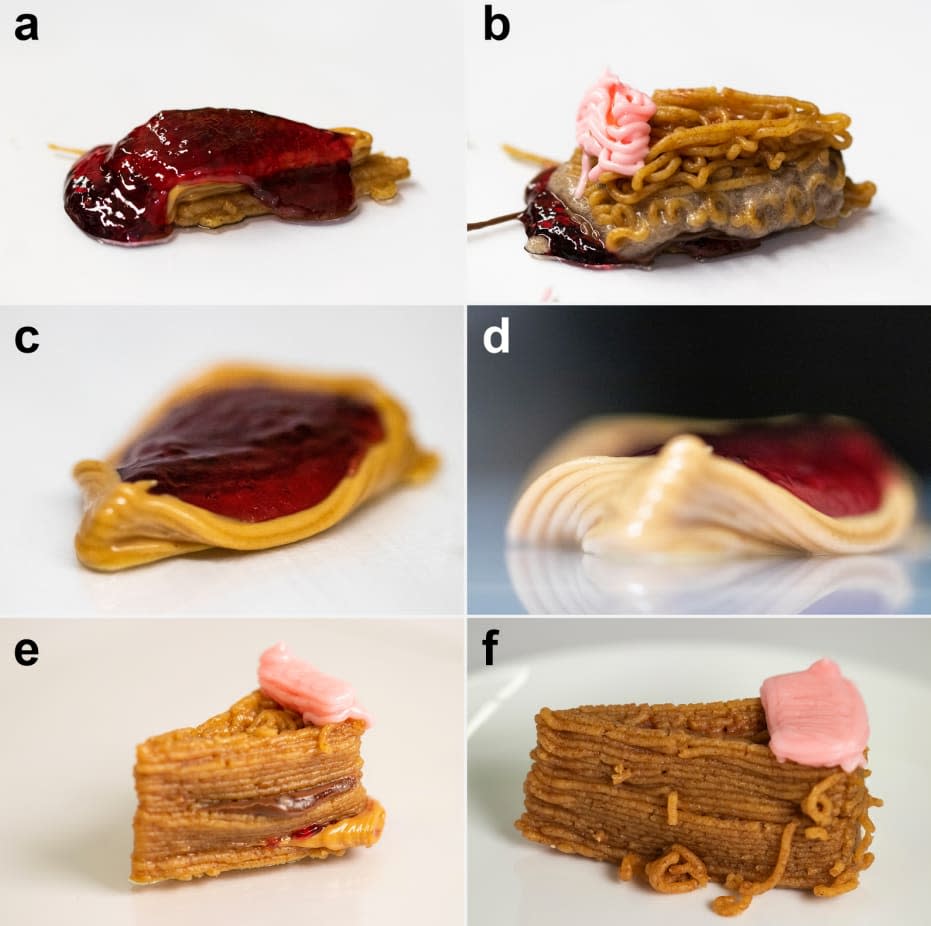Would You Eat This 3D-Printed Cheesecake?

3D printers have come a long way in the past few years. The tech offers a relatively affordable and accessible way to create all manner of materials from spitting out whole robots, to constructing homes and offices, to creating entire neighborhoods. Now, it might even become your next chef.
Researchers at Columbia University in New York City published a study on Tuesday in the journal npj Science of Food where they demonstrated a 3D printer capable of making an edible cheesecake. The device utilized “food inks” with ingredients such as Nutella, strawberry jam, peanut butter, and even graham crackers to create multiple layers until a cake was made.
Aside from having a machine that can create a delicious slice of cheesecake whenever you want, the study’s authors say that this could allow for better food safety as well as greater control over the nutritional content of your food. For example, if you’re a diabetic and your diet only allows for a certain amount of sugar, this machine could lead to a device that would let you precisely measure out that amount for your food.
“Digital cooking technologies allow an end consumer to take more control of the macro and micro nutrients that they consume on a per meal basis,” the authors wrote, “and due to the rapid growth and potential benefits of 3D technology advancements, a 3D printer may become a staple home and industrial cooking device.”
3D printing food isn’t an entirely new concept. It’s long been in the realm of science fiction but has gained more steam as a realistic technology in the past decade. More recently, a pair of scientists created a method of 3D printing faux-meat back in 2021. For this demonstration, though, the study’s authors wanted to take a bolder approach by 3D printing a complex food item using a whopping seven ingredients—which they claim is a record-setting amount for digital food.
Through trial and error including multiple attempts where the final product looked less-than-appetizing, the authors were able to combine graham cracker, peanut butter, Nutella, banana puree, strawberry jam, cherry drizzle, and frosting in order to create a cheesecake. To “cook” it, they used an array of near-infrared and blue lasers to heat the entire thing up.

Failed cheesecake prints. a. For initial designs, the jam could not hold its shape on a flat layer and needed to be pooled. b. With no supporting walls, graham cracker paste crushed softer ingredients below it. c, d. Thin walls were prone to crumbling and needed to be tapered. e. Adding graham cracker walls better supported the entire structure. f. Occasionally, the graham cracker paste would form squiggles due to incorrect z-height or drying of the ingredient.
“The design of our print became similar to constructing a home where floors, walls, and ceilings being the foundation (graham cracker) and inner pools (Nutella and peanut butter) holding softer ingredients within (banana and jelly),” the authors wrote.
While it might seem like a silly, sci-fi gimmick, the authors say that their digital cooking method represents the future of food. Not only can it give people greater control and customization over their diets, but it can also be good for the environment since the precision would allow you to cut down on food waste. Given the fact that a robot is essentially cooking your food, it could lead to less risk of foodborne illnesses.
The authors added, “An industry built around this technology may be on the horizon, creating a new vision of better nutrition, better food accessibility and palatability for many, increasing food safety and adding art and cutting-edge science to the most basic human need—nourishment.”
Got a tip? Send it to The Daily Beast here
Get the Daily Beast's biggest scoops and scandals delivered right to your inbox. Sign up now.
Stay informed and gain unlimited access to the Daily Beast's unmatched reporting. Subscribe now.

 Yahoo Sport
Yahoo Sport 





































